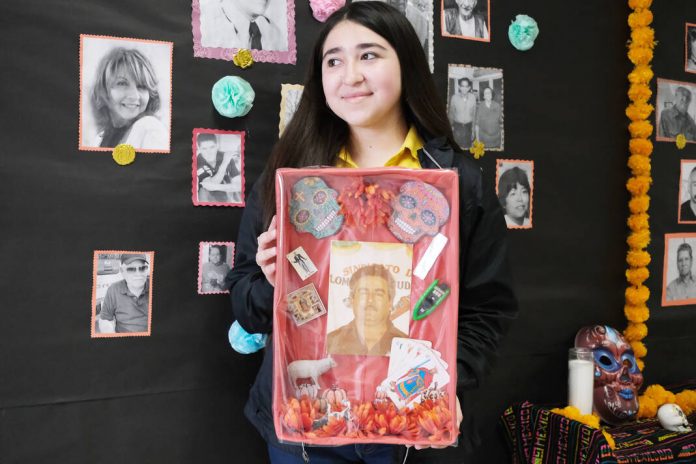The first thing to know about the Day of the Dead is that it’s not Halloween, although the two holidays occupy adjacent places on the calendar.
The Day of the Dead, or El Dia de los Muertos in Spanish, begins on Nov. 1 with All Saints Day for children who have passed away, followed on Nov. 2 by All Souls Day for everyone else, which is celebrated in Mexico, Latin America and around the world as the Day of the Dead — El Dia de los Muertos.
Students in Diana Sanchez’s Spanish classes at Besteiro Middle School, in the Spanish Club at Hanna Early College High School and in Marta Martinez’s Spanish classes there, have been learning all that and more about the holiday that celebrates and in a sense welcomes back one’s deceased relatives. It’s almost as though the Day of the Dead has its own season once Halloween has been dispensed with.
At Hanna, the Spanish Club put up a large Dia de los Muertos altar in the school’s foyer, complete with about 80 individual altars from students in Martinez’s Spanish classes. Each celebrates the memory of a loved one or loved ones who have passed away, along with items they held dear, foods they liked and something memorable about them, Martinez said.
“We are very proud of our heritage. We are Hispanic, we live here in the United States, but we wanted to keep our traditions going on and so we decided with the Spanish Club here at Hanna to create an altar and display it so that people could remember their loved ones on this day,” Martinez said.
It took time to gather all the materials and the altar came together thanks to the 21st Century After School Program, which gave students time to work on it after regular school hours, she said. As the Spanish Club members were working on the project, Martinez decided to have her Spanish students join in, with each getting an assignment to create a shoe b0x-sized altar to honor either a departed loved one or a famous artist in popular culture who has passed. A few students did their altar for a pet.
That was fine with Martinez as long as the altar included essential elements, 10 of them to get an A. These included incense, marigolds, any type of flower, papel picado, or paper with cut-outs to make it decorative, something religious like a rosary or a cross, food and drinks liked by the deceased, pan de muerto, a belonging, a picture, a catrina and catrin (the holiday’s icons) an offering of fruit or other foods, and a glass of water to welcome the loved one back on their journey from the nether world.
Across town at Besteiro Middle School, this is the second year that Spanish teacher Diana Sanchez has been assigning her sixth-, seventh- and eighth-grade Spanish students to create an altar in honor of a loved one who has passed away.
Sanchez said what she likes most about the altars is that creating them automatically involves the students’ parents. The altar is about a loved one who has passed, for example a grandparent, so the students have to get information about the person, who they usually didn’t know, from their mother or father.
“They’re getting to work with their parents. They’re putting it together with the contribution of everybody in their family, so the students are now learning and knowing of an ancestor that they never met,” Sanchez said. “They’re saying, ‘I’m doing this because of my grandfather or my great-grandfather. … They’re getting to know where their roots come from.”
Showing her altar, seventh-grader Alexi Reyes said her mother helped her know what her grandmother and grandfather were like. Horses, a corral and a fence are part of the altar since her grandfather was horseman and her grandmother a horsewoman, she said.
Aldo Lerma, also a seventh-grader, made his altar about his grandfather, Raul Lerma, who he said he got to know through his parents as part of the project.
Sanchez has been a Spanish teacher at Besteiro for four years. She has 180 students in mixed classes in the three middle school grades, she said.
“Once they start working on their altars, they don’t want to stop,” Sanchez said, adding that in the process of teaching Spanish she is able to include lessons in history, spelling, grammar, reading and writing.
She said Besteiro had a big turnout for its open house this year, and when parents found out about the Day of the Dead altars they enthusiastically asked how they could help.
Sanchez has developed a handbook on the history of the Day of the Dead, which she uses in teaching her students about the holiday and their Hispanic roots.
Officers of the Spanish Club at Hanna include Jennifer Martinez, president; Jane De Leon, vice president, Mia Navar, secretary; Emilio Gonzalez, treasurer; Angelica Paz, historian, and Juan Vigil and Jysiam Acosta, parliamentarians.





